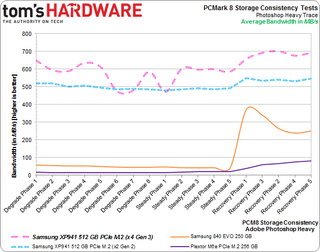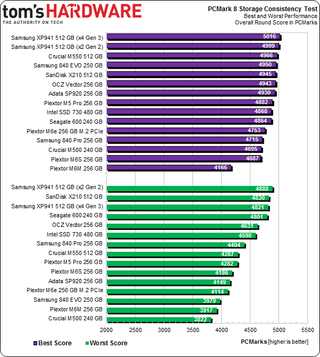A 1400 MB/s SSD: ASRock's Z97 Extreme6 And Samsung's XP941
Z97 ushers in new and exciting ways to attach and use storage devices. With support for M.2 PCIe and SATA Express, two sides of the same SSD coin, Z97 improves on Z87. But not everywhere. AsRock add to Z97 with some new tricks, and so we take a look.
Results: PCMark 8 Storage Consistency Test
PCMark 8's Storage Consistency test is fast becoming my favorite canned benchmark. Usually, that's code for lazy benchmarking. But the folks at Futuremark really came up with something stellar using PCMark 8's real-world workloads. What we end up with are trace-based tests played back to back, with specific conditioning that happens prior to each round. I've gone into a lot of depth on this in past reviews, so if you'd like to know more, I invite you to go back and read the background page.
PCMark 8 Storage Consistency Test: Bandwidth
PCMark 8's Adobe Photoshop (Heavy) trace is far and away the most intensive of the trace bundle. That's why we use it to show latency and bandwidth data for each of the 18 constituent rounds.

I'll let you guess which line on the graph represents Samsung's XP941.
Have you figured it out yet? Here's a hint: it's the fastest one. And not by a small amount, either. The XP941 serves up a benchmark-setting 700 MB/s in the recovery rounds. It dips as low as 500 MB/s in the debilitating degrade phase, which is simply unheard of. Even attached to the Z97 PCH's two-lane M.2 slot, it's still intensely quick. There's just a less capable interface supporting it.
Samsung's XP941 is as much as 20x faster than some of the quickest 6 Gb/s SSDs in this particular trace from this particular benchmark (that is to say our results don't necessarily map over to other workloads). It's hard to overlook the crushing defeat Plextor's M6e (in purple) and Samsung's own 840 EVO (in orange) sustain at the hands of this M.2 drive.
Despite my skepticism of AHCI-based PCIe storage, Samsung at least shows its XP941 to be an exception to the rule.
Stay on the Cutting Edge
Join the experts who read Tom's Hardware for the inside track on enthusiast PC tech news — and have for over 25 years. We'll send breaking news and in-depth reviews of CPUs, GPUs, AI, maker hardware and more straight to your inbox.

And here are the overall scores, showing the best and worst scores across PCMark 8's 18 rounds. No surprise, Samsung's XP941 owns the top tier. ASRock's Ultra M.2 slot hosting Samsung M.2 drive pushes as high as 5016 PCMarks. Attached to the PCH's M.2 interface, it registers a score of 4999.
Current page: Results: PCMark 8 Storage Consistency Test
Prev Page Results: Tom's Hardware Storage Bench v.1.0 Next Page ASRock's Z97 Extreme6: Only Satisfied By Samsung's XP941-
aminebouhafs Once an SSD in plugged into the Ultra M.2 slot, the bandwidth between central processing unit and graphics processing unit is cut-down by half. Therefore, while the end-user gets additional SSD performance, the end-user may lose some GPU performance because of insufficient bandwidth between it and the CPU.Reply -
JoeArchitect Very interesting article and a great read. Thanks, Chris - I hope to see more like this soon!Reply -
Eggz This makes me excited for X99! With 40 (or more) lanes, of PCI-e (probably more), there will be no need to compromise. We have to remember that the Z97 Chipset is a consumer-grade product, so there almost has to be tradoffs in order to justify stepping up to a high-end platform.Reply
That said, I feel like X99, NVMe, and and M.2 products will coincide nicely with their respective releases dates. Another interesting piece to the puzzle will be DDR4. Will the new storage technology and next-generation CPUs utilize it's speed, or like DD3, will it take several generations for other technologies to catch up to RAM speeds? This is quite an interesting time :) -
Amdlova Chris test the asrock z97 itx... and another thing... my last 3 motherboard from asrock and i want to say Asrock Rock's!Reply -
Damn_Rookie While storage isn't the most important area of computer hardware for me, I always enjoy reading Christopher's articles. Very well written, detail orientated, and above all else, interesting. Thanks!Reply -
hotwire_downunder ASRock has come along way, I used them a long time back with disappointing results, but I have started to use them again and have not been disappointed this time around.Reply
Way to turn things around ASRock! Cheap as chips and rock steady! -
alidan @aminebouhafs if i remember right, didn't toms show how much performance loss there is when you tape gpu cards to emulate having half or even a quarter of the bandwidth? if i remember right back than the difference was only about 12% from 16 lanes down to either 4 or 8Reply -
Eggz Reply13445787 said:@aminebouhafs if i remember right, didn't toms show how much performance loss there is when you tape gpu cards to emulate having half or even a quarter of the bandwidth? if i remember right back than the difference was only about 12% from 16 lanes down to either 4 or 8
PCI-e 3.0 x8 has enough bandwidth for any single card. The only downside to using PCI-e lanes on the SSD applies only to people who want to use multiple GPUs.
Still, though, this is just the mid-range platform anyway. People looking for lots of expansion end up buying the X chipsets rather than the Z chipsets because of the greater expandability. I feel like the complaint is really misplaced for Z chipsets, since they only have 16 PCI-e lanes to begin with. -
cryan ReplyOnce an SSD in plugged into the Ultra M.2 slot, the bandwidth between central processing unit and graphics processing unit is cut-down by half. Therefore, while the end-user gets additional SSD performance, the end-user may lose some GPU performance because of insufficient bandwidth between it and the CPU.
Well, it'll definitely negate some GPU configurations, same as any PCIe add-in over the CPU's lanes. With so few lanes to work with on Intel's mainstream platforms, butting heads is inevitable.
Regards,
Christopher Ryan
Most Popular

